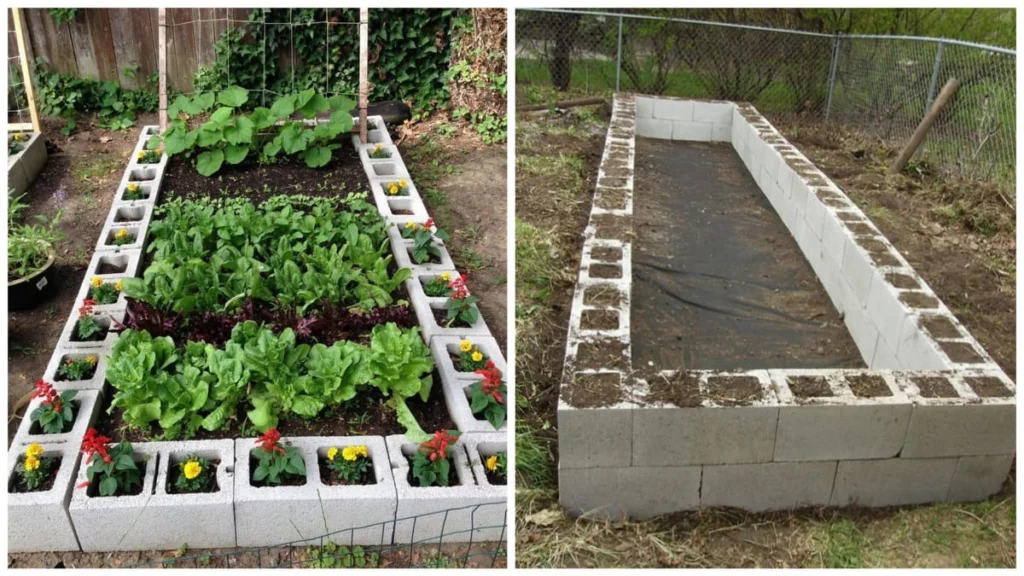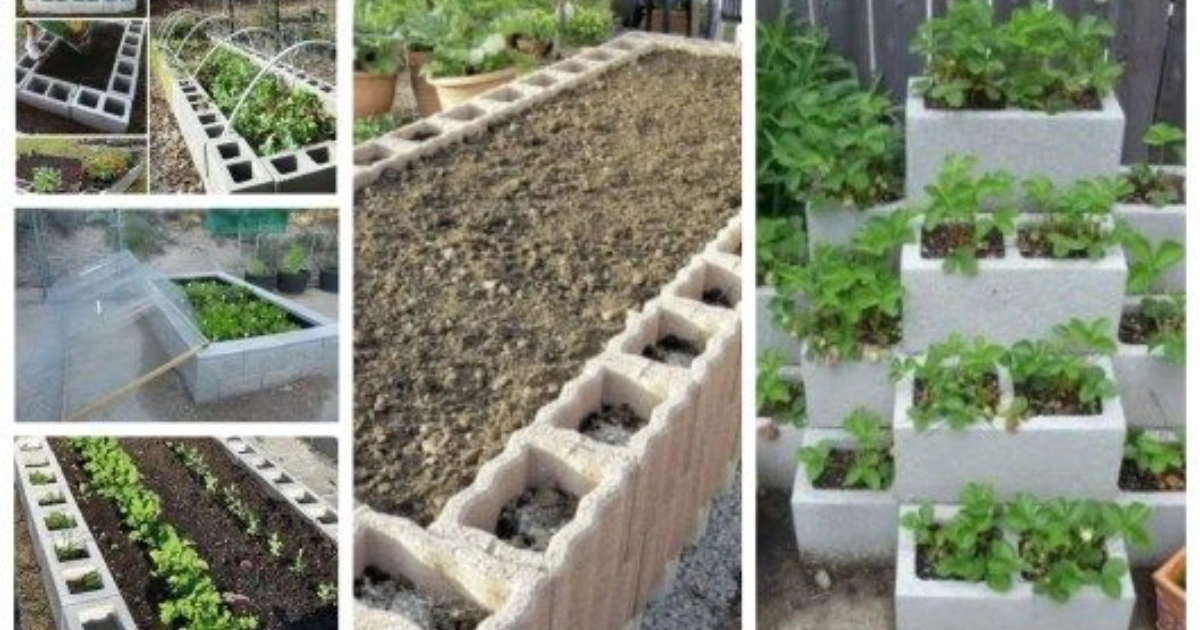Introduction: Transform Your Garden with a Concrete Block Raised Bed
If you’re looking to elevate your gardening experience, building a raised garden bed with concrete blocks is an excellent solution. Not only does this method offer exceptional durability, but it also provides an easy way to optimize your garden space. Concrete block raised beds are especially ideal for gardeners facing poor soil conditions, limited space, or those with mobility concerns. This step-by-step guide will take you through the process of constructing your own garden bed, from choosing the right materials to planting your first crop.
Benefits of Concrete Block Raised Garden Beds
Concrete block raised garden beds offer several distinct advantages that can make your gardening experience more enjoyable and productive:
1. Longevity and Durability
Concrete blocks are incredibly resilient to weather, pests, and rot, ensuring that your garden bed lasts for many years with minimal maintenance. This is particularly beneficial in areas with harsh weather conditions, where wooden beds may deteriorate over time.
2. Enhanced Soil Control
Raising your garden bed allows for better control over soil quality and drainage. You can fill the bed with high-quality soil, compost, and other organic materials, which helps prevent the problems often found with compacted or poor soil. The elevated structure also facilitates healthier root growth.
3. Ergonomic Gardening
One of the biggest benefits of raised garden beds is the ability to garden without having to bend down or kneel. This makes it ideal for individuals with back pain, arthritis, or those who simply prefer not to stoop down to ground level. Raised beds allow for more comfortable and accessible gardening.
4. Space Optimization
Concrete block raised beds come in a variety of shapes and sizes, making it easy to customize the garden space to fit your needs. Whether you are gardening in a small urban area or have a larger backyard, concrete block beds are an excellent way to maximize available space.
Materials and Tools You’ll Need
Before you begin, make sure you have the right materials and tools for the job:
Materials:
- Concrete Blocks: Standard 8″x8″x16″ blocks work best for most raised beds.
- Weed Barrier Fabric: Prevents unwanted weeds from growing under your bed.
- Quality Soil Mix: A mix of compost, peat moss, and perlite is ideal for healthy plant growth.
- Optional: Rebar for reinforcement, capstones for finishing edges, and construction adhesive for extra stability.
Tools:
- Shovel: For digging and leveling the ground.
- Rubber Mallet: To tap blocks into place without damaging them.
- Level: Ensures that each layer of blocks is perfectly even.
- Measuring Tape: For precise measurements to ensure proper alignment.
- Gloves: Protect your hands during construction.
Step-by-Step Guide to Building Your Concrete Block Raised Garden Bed
Step 1: Select an Appropriate Location
Choose a sunny spot for your raised bed, as most vegetables need at least 6-8 hours of direct sunlight each day. The area should also have good drainage to prevent waterlogging, which can harm your plants. If your location is in a low-lying area, make sure to provide a foundation that promotes drainage.
Step 2: Prepare the Ground
Start by clearing the area of grass, weeds, or debris. Use a shovel to level the ground, making sure it is smooth and flat. This foundation is crucial for ensuring that your concrete blocks sit level and remain stable over time.
Step 3: Lay the First Layer of Concrete Blocks
Place the first row of concrete blocks directly on the prepared ground. Use a level to check that each block is even. Tap them gently with a rubber mallet if needed. Take care to ensure that all blocks are aligned properly.
Step 4: Stack Additional Layers
To add height to your bed, stack more layers of concrete blocks. Make sure to stagger the joints between the blocks in each layer, much like laying bricks. This adds stability and prevents the bed from shifting. If desired, apply construction adhesive between the layers to keep them firmly in place.
Step 5: Install Weed Barrier Fabric
Lay weed barrier fabric at the bottom of the bed to prevent weeds from growing through the soil. Secure the fabric along the edges of the bed and allow it to extend slightly over the sides of the blocks for extra protection. This step ensures that weeds won’t compete with your plants for nutrients.
Step 6: Fill the Bed with Soil
Start by adding a layer of coarse materials like gravel or small branches at the bottom of the bed to ensure proper drainage. Then, fill the bed with a high-quality soil mix. Leave about 2-3 inches from the top of the bed to prevent water overflow when you irrigate your plants.
Step 7: Plant Your Garden
Now that your bed is ready, it’s time to plant! Choose plants that are suitable for the climate in your area. Consider companion planting to maximize space and boost plant health. For example, tomatoes and basil are great companions because basil can help repel pests from tomato plants.

Common Mistakes to Avoid
When building your concrete block raised bed, here are some common mistakes to avoid:
- Improper Drainage: Always ensure that your bed has proper drainage to prevent water from accumulating at the bottom. Standing water can lead to root rot and other issues.
- Overcrowding Plants: Be sure to give your plants enough space to grow. Crowded plants can compete for nutrients, leading to weak or diseased plants.
- Neglecting Soil Quality: Use high-quality soil and regularly amend it with compost or organic matter to keep your garden bed fertile. Healthy soil is crucial for healthy plants.
- Skipping Regular Maintenance: Check your raised bed regularly for pests, weeds, and any signs of structural damage. Performing routine maintenance ensures that your garden thrives year-round.
Seasonal Tips for Raised Bed Gardening
Raised bed gardening can be enjoyed year-round. Here’s a breakdown of how to care for your garden through the seasons:
- Spring: Prepare your garden bed by adding compost and planting early crops like lettuce, peas, and radishes.
- Summer: Consistent watering and mulching are key. Mulch helps retain moisture and keeps the roots cool during hot weather.
- Fall: Harvest your crops and prepare for the colder months. Consider planting cover crops, such as clover, to enrich the soil during the winter.
- Winter: If you live in a colder climate, protect the bed with frost covers to prevent the soil from freezing. You can also insulate the bed with a thick layer of mulch.
Tools and Materials Checklist
- Concrete Blocks 🧱
- Weed Barrier Fabric 🧵
- Quality Soil Mix 🌱
- Shovel 🛠️
- Rubber Mallet 🔨
- Level 📏
- Measuring Tape 📐
- Gloves 🧤
FAQs
1. Can I build a concrete block raised bed on a balcony?
Yes, as long as the balcony can support the weight of the bed and soil, and receives adequate sunlight.
2. How deep should my raised bed be?
A depth of 12-18 inches is ideal for most vegetables and herbs.
3. Do I need to seal the concrete blocks?
Sealing is optional. If you are concerned about potential leaching, consider using a food-safe sealant.
4. Can I use cinder blocks instead of concrete blocks?
Cinder blocks are lighter and cheaper, but they may not be as durable or suitable for growing edibles due to possible chemical leaching.
5. How do I winterize my raised garden bed?
Remove dead plants, add a layer of mulch, and consider using frost covers to protect the soil during the winter months.
Conclusion: Start Your Gardening Journey Today
Building a concrete block raised garden bed is a rewarding project that offers many benefits, from enhanced soil control to ergonomic gardening. With a little planning and care, you can create a garden bed that will thrive year after year.
For more gardening tips and inspiration, visit Secrets of the Green Garden.
Call to Action
Have you built a concrete block raised garden bed? Share your experiences and tips in the comments below! Don’t forget to share this guide with fellow gardening enthusiasts. Happy gardening! 🌿
- How to Build a Raised Garden Bed with Concrete Blocks – A step-by-step guide to building your own raised garden bed for durability and functionality.
- Top Soil and Mulching Tips for Raised Beds – Learn the best soil mix and mulching practices to ensure your raised bed thrives year-round.
- The Benefits of Raised Bed Gardening – Explore the many benefits of raised beds and how they can enhance your gardening experience.


buy amoxicillin online – buy amoxil tablets buy amoxicillin generic
buy fluconazole cheap – diflucan ca cheap diflucan 200mg
canada cialis for sale – https://ciltadgn.com/# what does generic cialis look like
cialis best price – https://strongtadafl.com/ does medicare cover cialis for bph
can you order viagra online – https://strongvpls.com/# sildenafil tablets 50mg
The thoroughness in this piece is noteworthy. purchase nolvadex
More articles like this would make the blogosphere richer. https://buyfastonl.com/gabapentin.html
The vividness in this tune is exceptional. https://ursxdol.com/sildenafil-50-mg-in/
The thoroughness in this draft is noteworthy. https://prohnrg.com/product/metoprolol-25-mg-tablets/
Good blog you possess here.. It’s hard to on elevated worth script like yours these days. I truly comprehend individuals like you! Withstand vigilance!! https://ondactone.com/product/domperidone/
This is a theme which is near to my verve… Many thanks! Faithfully where can I upon the acquaintance details for questions?
methotrexate drug
More posts like this would bring about the blogosphere more useful. http://www.zgqsz.com/home.php?mod=space&uid=846486
buy forxiga 10 mg online – buy forxiga 10mg pills buy dapagliflozin 10 mg
buy cheap orlistat – https://asacostat.com/# buy xenical tablets
More articles like this would frame the blogosphere richer. http://3ak.cn/home.php?mod=space&uid=230404
You can shelter yourself and your dearest by being heedful when buying prescription online. Some pharmacopoeia websites operate legally and offer convenience, reclusion, sell for savings and safeguards over the extent of purchasing medicines. buy in TerbinaPharmacy https://terbinafines.com/product/lasix.html lasix
This is the gentle of criticism I rightly appreciate. TerbinaPharmacy
I’ll certainly bring back to be familiar with more.
https://t.me/s/officials_pokerdom/3287
https://t.me/s/Martin_casino_officials